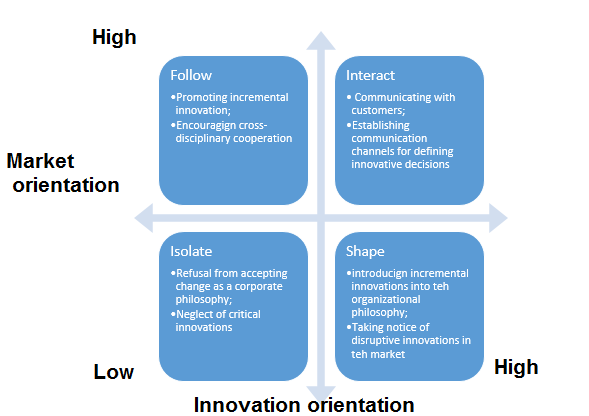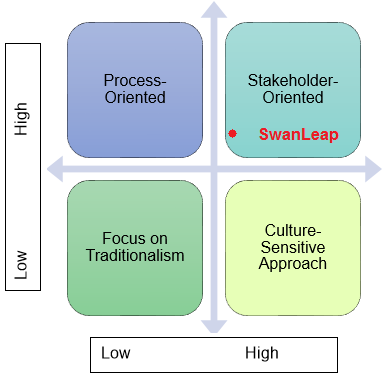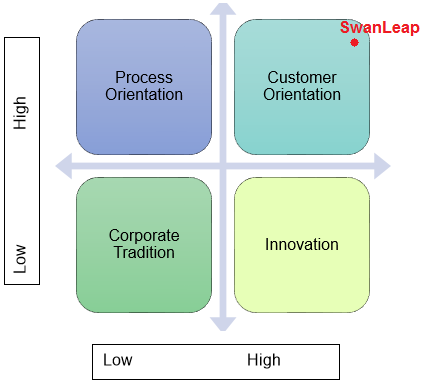- Introduction: The Entrepreneurial Marketing Framework and SwanLeap
- Supporting the Culture for Innovation at SwanLeap: The ICON Matrix at Work
- SwanLeap’s Current Position in the ICON Framework and Suggestions for the Future
- SwanLeap’s Financial Forecast and the Opportunities for Growth
- Conclusion
- Reference List
Introduction: The Entrepreneurial Marketing Framework and SwanLeap
Being up-to-date with innovative marketing strategies and able to target the culture-specific needs of the selected range of customers is a crucial skill that a company needs to develop to stay relevant. The principles of entrepreneurial marketing (EM) developed recently as a response to the fast-changing setting of the global market provide organizations with the exact opportunity of introducing a new marketing approach that will help to fulfill the needs of every customer, at the same time offering a cost-efficient approach for the supply chain. According to the definition offered by Sadiku-Dushi, Dana, and Ramadani (2019), EM is a marketing approach that helps to structure an innovation-driven approach toward promoting and branding an organization and its services. Remarkably, the notion of EM has evolved from symbolizing the idea of a deviation from the traditional marketing approaches to representing the innovation-driven concept for building a competitive advantage (Amin et al. 2016). Therefore, integrating EM into the organizational context is crucial to the increase of the process of value creation by using creativity and innovative resources to appeal to the target population.
Given the recent trend in introducing EM into the organizational setting of companies that strive to expand as the tool for capturing the target population’s attention fast, companies that provide analysis and give recommendations concerning the subject matter have gained importance. As a member of Lincoln Marketing Associates, one will be able to dive deeper into the processes within the selected company and explain what route of development in its EM framework it will need to adopt. When applying the specified notion to the setting of the SwanLeap organization, which is one of the pioneers in the supply chain management (SCM) enhancement within the IT industry, a member of the Lincoln Marketing Associates has to conclude that the company lacks the philosophy of innovation and the tools for boosting motivation in its organizational setting (SwanLeap 2019). To improve its performance and safeguard itself from multiple risks in the target market, SwanLeap will require an ICON-based framework that will direct the organization toward innovativeness as corporate philosophy and the corporate values.
Supporting the Culture for Innovation at SwanLeap: The ICON Matrix at Work

As the analysis performed above shows, the SwanLeap organization has been defaulting on the inclusion of innovation-driven philosophy into its setting. With the transformation of the company’s perspective on the idea of innovative management of resources and especially the application of different approaches toward improving the analysis of customers’ demands as they pertain to the culture of the target population, the firm will be able to handle the pressure of the competition within the target market quite efficiently. As the ICON matrix below shows, the firm has shifted from the traditional application of the ICON framework and the related principles toward the management of quality, which is critical in the ever-increasing competition of the global market (Fillis, Lehman & Miles 2017).
However, due to the restricted number of resources, SwanLeap has been defaulting on the management of its communication issues, which is why it is highly recommended to revisit SwanLeap’s current framework for managing its data analysis and especially the adoption of a culturally sensitive approach toward meeting the needs of its target demographic. With the shift of responsibilities for the transportation of the raw materials onto the vendor, SwanLeap will have certain leeway in reallocating its finances and investing in the development of innovative tools for the improvement of its supply chain, customer relations, and especially the allocation of its finances.
SwanLeap’s Current Position in the ICON Framework and Suggestions for the Future

As the matrix provided above shows, SwanLeap has seen a significant change throughout its local performance. The identified changes are mostly positive, with the company updating its strategies for targeting its customers and managing internal processes. With the key drivers for the company’s growth being mostly political relationships, infrastructure, tax systems, and shifts in the demographics, SwanLeap’s current ICON framework needs to be represented by a shift toward the adoption of a more flexible and technologically advanced IT infrastructure that will offer the firm greater freedom in the choice of its communication techniques. The issue of product quality, to which SwanLeap has been paying particular attention and on which it has been building its competitive advantage, is worthy of special appreciation. However, the ICON matrix above could still use vast and profound changes regarding its communication framework (namely, the expansion of the current communication channels) and the rearrangement of resource allocation strategies (Karjaluoto, Mustonen & Ulkuniemi 2015). However, by far the most glaring omission in the current approach utilized by SwanLeap outlined in the ICON framework above is the absence of an innovation-driven corporate philosophy, which would affect decision-making, help to improve communication, and redefine SwanLeap’s approach toward its SCM.
To address the marketing situation that can currently be observed at SwanLeap, the company marketing experts will have to adopt the EM framework from the perspective of innovative thinking and shape SwanLeap’s present Segmentation, Targeting, and Positioning approach in the way that will help to encompass culture-specific needs of its target population. Introducing a different approach toward the segmentation framework will become simpler once the firm considers the characteristics of its target customers such as the level of expertise in navigating the target market, the size and scope of the organization that selects SwanLeap’s services, and the tools for improving communication with its clientele (Kannan 2017). Given the nature of SwanLeap’s target industry, the design of a wide communication channel for managing data and conversing with its customers is especially important since the firm deals with freight transportation. Thus, orders for delivering products from and to other countries are likely to become a common request, which means that the approaches toward marketing based on the principles of EM and especially on the assessment of the sociocultural environment in which SwanLeap will function is entirely indispensable.
SwanLeap’s Financial Forecast and the Opportunities for Growth
Currently, the company has been showing stupendous progress in its performance, with its revenues peaking at approximately $900,000 (SwanLeap n.d.). However, the company will still need a boost since its current approach toward leveraging its resources and minimizing costs is quite unstable. Without a strong and well-established infrastructure, SwanLeap will inevitably default on the delivery of the end product to its retailers, thus causing the entire supply chain to collapse (Becherer & Helms 2016). However, with the adoption of the framework based on the innovation-driven vendor management of inventory (VMI), SwanLeap will make a huge step on the path toward massive improvement. By definition, the application of the VMI technique implies that significant pressure is taken from a company and transferred to the vendor, which means that SwanLeap will have a broader range of opportunities for shaping its approach toward the allocation of resources, including investment in the marketing processes, R&D, and communication (Sadiku-Dushi, Dana & Ramadani 2019). These are especially significant for SwanLeap due to the need to adjust to the

As the figure above shows, SwanLeap’s current progress is quite stable, yet it could be improved significantly once the principles of innovation-driven EM are integrated into its business architecture and interwoven into its decision-making. The organization has shown impressive resilience to risks and with the approach for managing financial resources that SwanLeap has been using so far, the firm is unlikely to suffer any major impacts in the future. Nonetheless, to reinforce the current risk management framework and safeguard SwanLeap from any disturbances in its financial progress, additional precaution measures have to be adopted (Whalen et al. 2016). Using the EM perspective, one may offer the dynamic forecasting model. The proposed change aligns with the progression from the existing ICON framework to the desired combination of innovativeness and appeals to customer’s culture-specific needs, thus elevating the organization above the rest of the companies occupying the same niche.
Indeed, the dynamic forecast model will help to seal the process of managing incoming data promptly and weaving it into the fabric of the current EM strategy, thus allowing SwanLeap to identify trends within the target market. According to Huang et al. (2017), the dynamic forecast approach allows updating the entire logistics system to increase the accuracy and expeditiousness of the process: “Through this system, producers can obtain timely and precise production forecast information, so as to organise production activities reasonably” (p. 436). Therefore, the proposed dynamic forecasting tool aligns with the newly developed ICON framework for the SwanLeap organization more consistently than the currently used one (Abdullah, Yaakub & Subhan 2018).

As Figure 4 above shows, the changes in the ICON archetype of SwanLeap will have to be geared toward the reassessment of the organization’s approach toward innovation as a part of the organizational standards and the corporate philosophy. The described goal aligns with the idea of EM that suggests a change in the approaches toward value creation and the management of the organization’s resources. The idea of innovation is outright stated in the definition of M, which supports the importance of the specified concept in the changes within SwanLeap’s framework. However, there is an important distinction between the current perception of EM and the principles suggested as the model for decision-making at SwanLeap. While the existing definition states that a company has to incorporate innovative approaches in handling the issues associated with resources and risk management, the proposed one implies that innovation should be instilled into the very backbone of SwanLeap’s corporate philosophy. Thus, the organization will become capable of adjusting its SCM toward the alterations in the global market and the
When applying the ICON framework to the company’s performance and decision-making, one will have to argue that, presently, SwanLeap can be defined as an Encourager since it does not actively facilitate innovation in its relationship to the customer and its EM approach, yet it does not refrain from introducing it into the organizational context. Therefore, the company will have to examine different opportunities for steering its current EM approach toward innovative thinking and especially innovative marketing. However, a proposed incentive for change should not be consolidated in the marketing department. Instead, the notion of innovation, including both incremental and non-incremental ones, has to be incorporated into SwanLeap’s corporate philosophy. Thus, the organization will alter its decision-making in a way that will allow it to evolve and attract the attention of wider audiences.
The importance of innovation on the corporate level as the means of shaping SwanLeap’s performance is justified by the necessity to encourage homogeneity in its operations, in general, so that SwanLeap could coordinate its processes respectively. Thus, the decision-making at SwanLeap will be informed by the plethora of factors that affect its performance, as well as the issues within other departments. Specifically, the challenges associated with the management of resources will be handled properly even though the firm needs investments into its supply chain (Whalen & Akaka 2016). The ability to allocate resources wisely and plan the future action carefully, drafting a well-informed plan, will become possible once the idea of innovation infiltrates every aspect of SwanLeap’s performance, thus making it significantly
Therefore, it is instrumental to adjust the company’s marketing approach so that the company could develop a perspective based on the idea of innovativeness and the promotion of incremental change in every domain of its performance, especially regarding the management of its supply chain and the marketing strategies. Thus, as the updated ICON matrix shows, SwanLeap will develop the required resilience toward shifts in demand and expenses, at the same time leaning to adopt new marketing tools that will help it to increase its popularity among customers. For instance, the company will need to pay much greater attention to the culture-specific demand of its demographics, namely, the methods of communication and the use of language in marketing. The latter is of particular importance since the issue of a cross-cultural misunderstanding occurring due to language differences is highly probable (Yang 2018). Therefore, SwanLeap will have to shift its approach in EM toward the assessment and analysis of the culture-specific characteristics of its market, with the elaboration on the possible effects that its current marketing campaign, the brand image, and product, and the details such as the company’s logo, its slogan, and other important aspects of its current brand personality will produce on the global population (Renton et al. 2015).

The fact that the company operates in the IT-sphere and provides the services linked to artificial intelligence (AI) is also highly indicative of the need to revisit the approach toward marketing and the representation of the product. SwanLeap will have to position itself as a company that embraces the philosophy of innovation wholly and strives to maintain innovativeness in its approaches toward the transportation of freight. Moreover, despite being a pioneer in its target niche, SwanLeap will have to emphasize its unique competitive advantage, which will be represented by the introduction of control for customers regarding the process of tracking the freight transfer and delivery, as well as the means of communicating with the organization. The focus on the approaches that will help to tailor the process specifically to the needs of its customers, as well as the emphasis on culturally sensitive approaches, will elevate SwanLeap to the top of its chain.
Conclusion
SwanLeap has seen significant changes, as the progression of the company’s strategy is shown in the ICON matrix. The company has progressed from a rather basic understanding of its target market to a much more elaborate assessment of customers’ needs. However, to create a competitive advantage, SwanLeap will need a more effective SCM framework, which is why it has to revisit its current approach toward allocating financial resources, as well as managing information within its organizational environment and building the system of managing SCM oriented toward innovation.
In addition, changes to the leadership approach are highly recommended so that SwanLeap could adjust to the alterations to its decision-making framework and introduce staff members to the ideas of corporate social responsibility, organizational values as the key determinant in making company-related choices, and the principles of information sharing. Thus, the analysis of customers’ needs and the ability to apply culture-specific customer-oriented approaches to the company’s design will be possible. Overall, the use of the EM-related tools within the corporate setting of the SwanLeap organization is expected to lead to a much more accurate analysis of the data, which, in turn, will affect the organization’s ability to manage the issues associated with the company’s environment.
Reference List
Abdullah, NAHN, Yaakub, S & Subhan, M 2018, ‘Moderating effect of logistics and supply chain issues on the relationship between entrepreneurial orientation and market orientation’, Journal of Social Science and Humanities, vol. 1, no. 2, pp. 27-34.
Amin, M, Thurasamy, R, Aldakhil, AM & Kaswuri, AHB 2016, ‘The effect of market orientation as a mediating variable in the relationship between entrepreneurial orientation and SMEs performance’, Nankai Business Review International, vol. 7, no. 1, pp. 39-59.
Becherer, RC & Helms, MM 2016, ‘The role of entrepreneurial marketing in improving market share for small businesses facing external environmental or resource challenges’, Journal of Business and Entrepreneurship, vol. 27 no. 2, pp. 119-147.
Fillis, I, Lehman, K & Miles, MP 2017, ‘The museum of old and new art: leveraging entrepreneurial marketing to create a unique arts and vacation venture’, Journal of Vacation Marketing, vol. 23, no. 1, pp. 85-96.
Huang, F, Xie, X, Wang, C & Liu, P 2017, ‘Early warning system of production and marketing price of seasonal agricultural products’, In 2017 6th International Conference on Measurement, Instrumentation and Automation (ICMIA 2017), Atlantis Press, Amsterdam, pp. 433-439.
Kannan, PK 2017, ‘Digital marketing: a framework, review and research agenda’, International Journal of Research in Marketing, vol. 34, no. 1, pp. 22-45.
Karjaluoto, H, Mustonen, N & Ulkuniemi, P 2015, ‘The role of digital channels in industrial marketing communications’, Journal of Business & Industrial Marketing, vol. 30, no. 6, pp. 703-710.
Renton, M, Daellenbach, U, Davenport, S & Richard, J 2015, ‘Small but sophisticated: Entrepreneurial marketing and SME approaches to brand management’, Journal of Research in Marketing and Entrepreneurship, vol. 17, no. 2, pp. 149-164.
Sadiku-Dushi, N, Dana, LP & Ramadani, V 2019, ‘Entrepreneurial marketing dimensions and SMEs performance’, Journal of Business Research, vol. 100, pp. 86-99.
SwanLeap 2019, About us, Web.
SwanLeap n.d., Visibility solutions for NextGen supply chains, Web.
Whalen, P, Uslay, C, Pascal, VJ, Omura, G, McAuley, A, Kasouf, CJ & Gilmore, A 2016, ‘Anatomy of competitive advantage: towards a contingency theory of entrepreneurial marketing’, Journal of Strategic Marketing, vol. 24, no. 1, pp. 5-19.
Whalen, PS & Akaka, MA 2016, ‘A dynamic market conceptualization for entrepreneurial marketing: the co-creation of opportunities’, Journal of Strategic Marketing, vol. 24, no. 1, pp. 61-75.
Yang, M 2018, ‘International entrepreneurial marketing strategies of MNCs: bricolage as practiced by marketing managers’, International Business Review, vol. 27, no. 5, pp. 1045-1056.